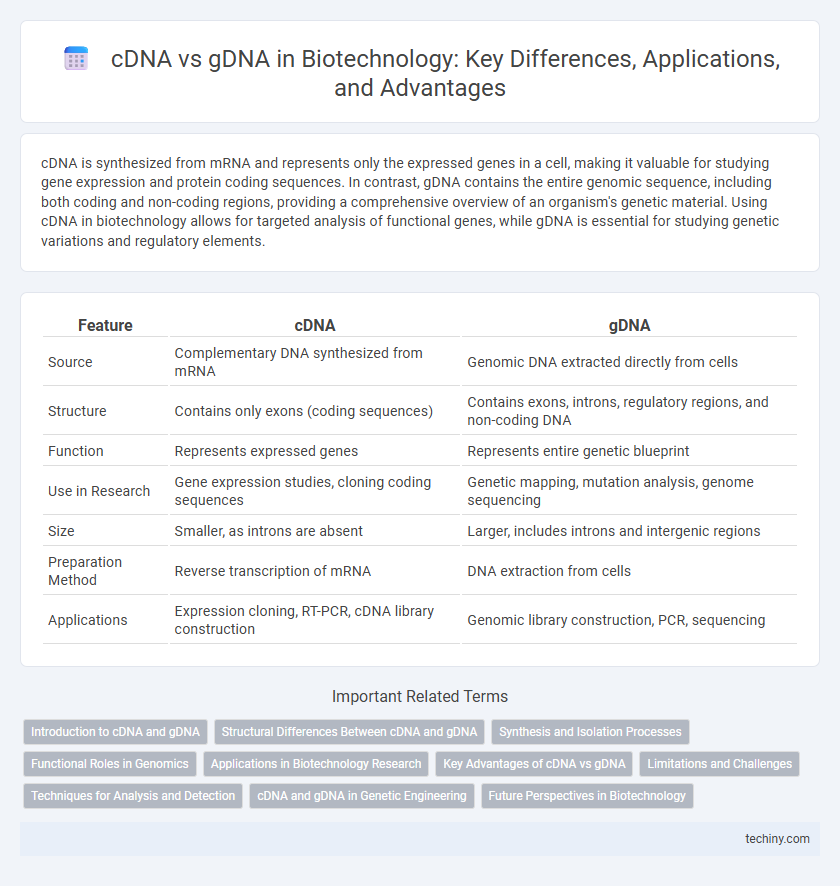cDNA is synthesized from mRNA and represents only the expressed genes in a cell, making it valuable for studying gene expression and protein coding sequences. In contrast, gDNA contains the entire genomic sequence, including both coding and non-coding regions, providing a comprehensive overview of an organism's genetic material. Using cDNA in biotechnology allows for targeted analysis of functional genes, while gDNA is essential for studying genetic variations and regulatory elements.
Table of Comparison
| Feature | cDNA | gDNA |
|---|---|---|
| Source | Complementary DNA synthesized from mRNA | Genomic DNA extracted directly from cells |
| Structure | Contains only exons (coding sequences) | Contains exons, introns, regulatory regions, and non-coding DNA |
| Function | Represents expressed genes | Represents entire genetic blueprint |
| Use in Research | Gene expression studies, cloning coding sequences | Genetic mapping, mutation analysis, genome sequencing |
| Size | Smaller, as introns are absent | Larger, includes introns and intergenic regions |
| Preparation Method | Reverse transcription of mRNA | DNA extraction from cells |
| Applications | Expression cloning, RT-PCR, cDNA library construction | Genomic library construction, PCR, sequencing |
Introduction to cDNA and gDNA
cDNA (complementary DNA) is synthesized from mRNA transcripts using reverse transcriptase, representing only the expressed genes without introns, making it essential for studying gene expression. In contrast, gDNA (genomic DNA) encompasses the entire genome, including exons, introns, and regulatory regions, providing a comprehensive genetic blueprint. Understanding the differences between cDNA and gDNA is crucial for applications in cloning, gene expression analysis, and molecular diagnostics.
Structural Differences Between cDNA and gDNA
cDNA is synthesized from mature mRNA and lacks introns, representing only the expressed coding regions of a gene, whereas gDNA contains both introns and exons, encompassing the entire genetic sequence including regulatory regions. The absence of non-coding sequences in cDNA results in a continuous sequence that corresponds strictly to protein-coding regions, making it ideal for gene expression studies. In contrast, gDNA's complex structure with introns and intergenic regions provides comprehensive genomic information essential for understanding gene regulation and genome organization.
Synthesis and Isolation Processes
cDNA synthesis involves reverse transcription of mature mRNA using reverse transcriptase enzymes, enabling the study of expressed genes without introns. In contrast, gDNA isolation extracts the entire genomic content from cells, including both coding and non-coding regions, typically using cell lysis, protein removal, and DNA precipitation methods. The cDNA process is more selective for gene expression analysis, while gDNA isolation provides a comprehensive representation of the organism's genetic material.
Functional Roles in Genomics
Complementary DNA (cDNA) represents the actively expressed genes in a cell by being synthesized from messenger RNA, making it essential for studying gene expression and analyzing functional transcripts in genomics. Genomic DNA (gDNA) contains the entire genetic blueprint, including introns and regulatory sequences, crucial for understanding genetic variations, inheritance, and genome structure. Functional genomics leverages cDNA to explore protein-coding regions and transcriptomics, while gDNA provides comprehensive insights into gene organization and non-coding elements influencing gene regulation.
Applications in Biotechnology Research
cDNA is widely used in gene expression studies, enabling researchers to analyze mRNA transcripts without introns, which helps in cloning and producing recombinant proteins. gDNA contains the complete genomic sequence, including introns and regulatory regions, making it essential for studying genetic variations, epigenetics, and genome editing applications such as CRISPR. Biotechnological research leverages cDNA for transcriptome analysis and gDNA for comprehensive genomic mapping and mutation analysis.
Key Advantages of cDNA vs gDNA
cDNA offers the key advantage of representing only the expressed genes by being synthesized from mature mRNA, which eliminates intronic regions and non-coding sequences present in gDNA. This allows for precise analysis of gene expression and easier cloning of coding sequences without regulatory elements or introns. Furthermore, cDNA enables efficient study of alternative splicing variants and facilitates functional assays focused solely on protein-coding regions.
Limitations and Challenges
cDNA lacks non-coding regions such as introns and regulatory sequences present in gDNA, limiting its use in studying gene regulation and genomic architecture. gDNA is more complex and contains repetitive sequences, making amplification and sequencing challenging, especially for large genomes. Both types require careful extraction and handling to avoid contamination and degradation, impacting downstream applications like cloning and gene expression analysis.
Techniques for Analysis and Detection
cDNA is primarily analyzed through techniques such as reverse transcription PCR (RT-PCR) and quantitative PCR (qPCR), which amplify specific gene transcripts to assess gene expression levels. In contrast, gDNA analysis often involves methods like restriction fragment length polymorphism (RFLP) and whole-genome sequencing to detect genomic variations and mutations. Techniques such as Southern blotting and PCR-based genotyping are also commonly used for gDNA to identify structural variations and single nucleotide polymorphisms (SNPs).
cDNA and gDNA in Genetic Engineering
cDNA (complementary DNA) is synthesized from mRNA and represents only the expressed genes without introns, making it essential for gene cloning and expression studies in genetic engineering. gDNA (genomic DNA) contains the entire genetic sequence, including introns and non-coding regions, useful for studying regulatory elements and genomic organization. The choice between cDNA and gDNA depends on whether precise gene expression or entire genomic context is required in genetic modification experiments.
Future Perspectives in Biotechnology
Future perspectives in biotechnology emphasize the expanding use of cDNA for precise gene expression analysis and targeted therapeutic development, surpassing the broader utility of gDNA. Advancements in sequencing technologies and CRISPR-based gene editing leverage cDNA's specificity to refine disease modeling and personalized medicine. Integration of cDNA with multi-omics data accelerates biomarker discovery and synthetic biology innovations critical for next-generation biotechnological applications.
cDNA vs gDNA Infographic

 techiny.com
techiny.com